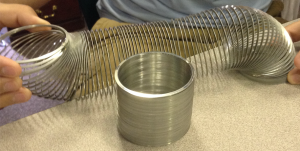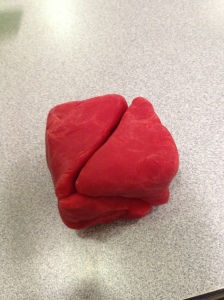Geometric Measure and Dimension G-GMD
Explain volume formulas and use them to solve problems
1. Give an informal argument for the formulas for the circumference of a circle, area of a circle, volume of a cylinder, pyramid, and cone. Use dissection arguments, Cavalieri’s principle, and informal limit arguments.
2. (+) Give an informal argument using Cavalieri’s principle for the formulas for the volume of a sphere and other solid figures.
How do you provide students an opportunity to make sense of volume formulas? I’ve written before about how we use informal limit arguments to make sense of volume formulas for the cylinder and prism and then Power Solids to make sense of volume formulas for the cone and pyramid.
Using a slinky, we briefly discuss Cavalieri’s principle.
Solids: equal height, cross sections for each plane parallel to and including the bases are have equal area.
What are the implications of Cavalieri’s principle here? (the two solids have the same volume)

And here? (none, as the conditions aren’t met)

When we get to the volume of a sphere, I’ve always told my students they’ll have to wait until calculus to make sense of the formula.
(I sneak in this exercise in calculus and wait for someone to notice the result.)
If I ever made sense of the volume of a pyramid or sphere using Cavalieri’s principle while I was in school, I don’t remember. (Surely I’m not the only one.) This year, though, I’m determined to do better. I’ve been saving Pat Mara’s TI-Nspire documents to think this through.
How can you use these images along with Cavalieri’s principle to make sense of the formula for the volume of a square pyramid compared to the volume of a square prism with base and height equal to the pyramid?
When I got out the play dough to make more sense of the dissection of the cube, my coworker joined me. Our solid isn’t beautiful, but we get why the three square pyramids have the same volume and why one square pyramid will have a volume that is one-third of the square prism with base and height equal to the pyramid.
What can you say about this square pyramid and cone?
I like the visual image of seeing cross sections that aren’t congruent but have equal area.
Now for the sphere.
What do you see?
On the left, a hemisphere.
On the right, a cone cut out of a cylinder.
What’s the same about the solids?
The sphere and the cylinder have equal radii and equal heights. Since the “height” of the sphere is its radius, the cylinder has height equal to radius.
What are the horizontal cross sections?
On the left, a circle. The radius decreases as the cross section slices go from bottom to top.
On the right, a “washer” (or officially, an annulus), where the outer radius is always the radius of the cylinder (constant) and the inner radius is equal to the height of the smaller cone formed with the inner circle of the slice and the center of the base (shown by similar triangles).
Dynamic geometry software shows us that the cross sections have the same area. Convince yourself that they do.
I convinced myself here:
And then I looked at the next page, which allowed me to move the cross sections and see the similar triangles change.
So what does this tell us about the volume of a hemisphere?
According to Cavalieri’s Principle, it has the same volume as the solid on the right.
How can you calculate the volume of the solid on the right?
Subtract the volume of the cone from the volume of the cylinder.
And then what about the height of a sphere for which this hemisphere is half?
The Illustrative Mathematics task Use Cavalieri’s Principle to Compare Aquarium Volumes could be helpful for exploring Cavalieri’s Principle. I’ve had it tagged for several years now. Maybe this will be the year we take time to try it.
And so the journey as both learner (student) and Learner (teacher) continues, with gratitude for those who share their work and those who are willing to pause their work long enough to learn alongside me …













